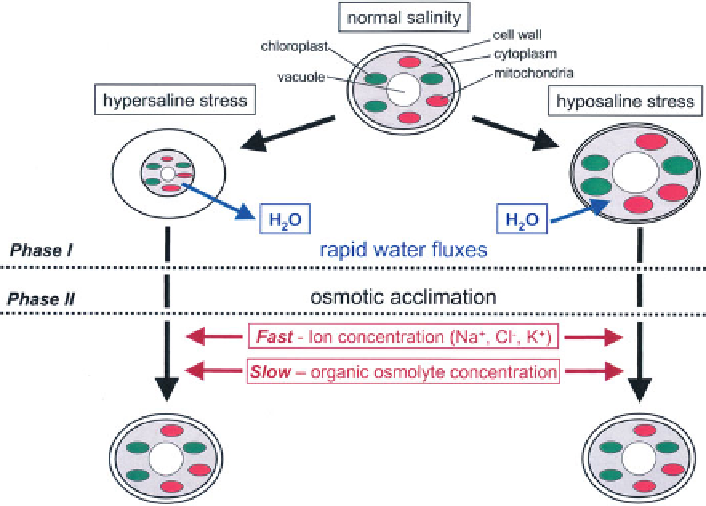Biology Reference
In-Depth Information
Fig. 5.2
Schematic summary of the processes of osmotic acclimation in seaweeds after hypersa-
line and hyposaline stress leading to a new steady state
The response of seaweeds to salinity changes is a well-regulated biphasic
process. Phase I is characterized by rapid changes in turgor pressure caused by
massive water fluxes in or out of the organism following the osmotic gradient.
Phase II represents the process of osmotic acclimation, i.e., adjustment of the
intracellular concentrations of the osmotically active inorganic ions and organic
osmolytes until a new steady state is achieved (Fig.
5.2
). Both phases are part of a
feedback loop that comprises the osmotic acclimation.
The water fluxes during phase I are rapid processes with half times in seaweeds
lasting from minutes to hours (Zimmermann and Steudle
1978
), resulting in water
influx under hyposaline conditions or water efflux during hypersaline stress, both of
which mitigate at least transiently the osmotic stress (Fig.
5.2
). Most importantly,
these processes follow passive “osmometer” behavior, and depend on physico-
chemical properties of the cell-wall membrane complex such as the hydraulic con-
ductivity (water permeability, water channels). So far it has been assumed that all
phase I processes are not under metabolic control (Kirst
1990
), but since the discovery
of the so-called aquaporins asmembrane-locatedwater channels it seems that cells can
control their water content (T
ornroth-Horsefield et al.
2006
). These channels are
widely distributed in all kingdoms of life. They form tetramers in the plasmalemma,
and facilitate the transport of water through the lipophilic membrane. Probably, many
water channels at the cytoplasmic membrane open for short time during salt stress, and
not only water but also small water-soluble solutes are taken up or lost during phase I.
€

